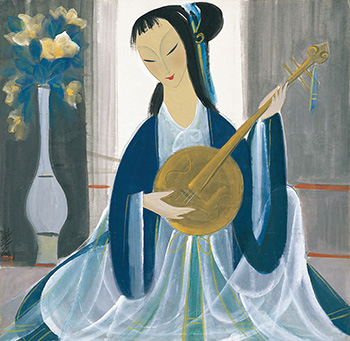ILLUSTRATED:
Zhou Weiming ed., Collection of Art Garden Studio No.72: Sanhuai Tang's Modern Chinese Paintings, People Fine Arts Publishing House, Shanghai, 2004, color illustrated no. 40, p. 25
Catalogue Note:
Painter Shiy De-jinn once praised Lin Fengmian’s art as the “Innovation Pioneer of Chinese Painting” He thought that being an innovator in painting was ten times far more difficult than being a successor. To truly revolutionize Chinese painting is easier said than done. To remake a prototype steeped in several thousand years of cultural essence would be even more difficult. Yet, Lin Fengmian managed it. He surpassed traditions and combined the best of both East and West. His paintings opened up a whole new horizon.
Lin Fengmian was among the first generation of artists from China to study in France. In 1920, he went to further his studies in Paris, enrolling into a collegiate education to learn western painting. In the beginning he loved intricate realistic paintings. Styles such as Classical paintings, Fauvism and Cubism brought new impact on his visual sense, but, inspired by his teacher, he turned to study Chinese sculptures, paintings and ceramic art in eastern museums, developing a keen interest in traditional Chinese art. The interest shown in the East was synonymous with European ideologies then. Even artists such as Picasso and Matisse were learning from the experiences of Eastern art. Lin Fengmian once copied the simplistic landscapes, flowers and birds found on ceramics, while the shapes of the vases and their cool glossy sensations were reflected in his later pictures of cranes and beautiful ladies. Folk art such as shadow puppets, Han script carvings etc, further nourished his painting lingo.
Lin Fengmian is the youngest principal ever in charge of an art school in the history of China. He was only 26 when he returned home to take charge of affairs at the Beijing School of Art. Two years later, he set up the National Academy of Art (i.e. Hangzhou College of Art) and assumed the role of principal, introducing western modern art ideologies into China. During the period of his involvement in art education, Lin Fengmian influenced many upcoming students with his free and easy approach to teaching and learning. He is hence regarded as one of the greatest artists and art educators in the 20th century.
The current auction lot, “Lady in a Green Dress” is one of Lin Fengmian’s early paintings on beautiful ladies. The approximate date of completion is the 1950s. By then, he had already left his teaching post, choosing to ignore the mundane affairs and to reside in Shanghai without any fanfare. This was the most critical period in the formation of the artist’s personal style. Shiy De-jinn believes that the seemingly endless period of residency in Shanghai after 1952 was the most productive period for Lin Fengmian’s works of art. His paintings took in equal proportions of elements from traditional Chinese art as well as 20th century Parisian new art. Taking figure paintings for example, his ladies in ancient costumes adopted sitting postures alike Guanyin, the bent body shapes are Matisse-like, while the inclining postures are from Modigliani’s; opera figures, on the other hand, combines the structure of cubism with the shapes of shadow puppets.
Among the many characters composed in Lin Fengmian’s works, the image of a beautiful lady is a unique one among his many manners of composition. Such artistic feminine portrayals are comparable to the Venus in Western art. Audiences passionate about his art have claimed it to be the”Oriental Goddess of Beauty”. The formation of such a “Goddess of Beauty” has to do with the artist’s unique experiences in judging beauty. As such, it has drawn our focus upon the compositions by Lin Fengmian portraying subjects of relevant figures.
Pertaining to Lin Fengmian’s style of drawing ladies, the artist once recalled saying, they are “primarily from accepting the art of Chinese porcelain” “especially the influences from the clear transparent colors of Song dynasty’s Guan Kiln and Longquan Kiln, employing in them a kind of inspirational technique that I derived from these things.” The form and language associated with Lin Fengmian’s portraits of ladies embodies a purity of figures, transparency of colors and elegance in style. Through a simple and elegant form, the characters in the portrait reveals an enchanting sentiment that stems right from the artist’s inner calling to memories of youth and sublimation of feelings. As such, the feminine images of the Oriental Goddess of Beauty as seen in Lin Fengmian’s compositions awaken the audiences’ solemn and innocent beautiful inner feelings to become a unique symbol and image of feminine beauty in Chinese art.
Though the woman in “Lady Playing Moon Guitar” is in Western dress, her appearance such as the eyebrows, almond eyes and cherry-like mouth were from the archetypes of beauty in traditional Chinese literature. The “Moon Guitar” is a traditional Chinese musical instrument. The earliest record of the lady playing moon guitar theme in Chinese traditional art dates back to the Tang dynasty, with frescoes of performing musicians at the Dunhuang Caves. During the War of Resistance against Japan and his retreat to Chongqing, Lin would have certainly seen the famous exhibition of Dunhuang frescoe paintings made by Chang Dai-chien. During the early 1950’s he himself experimented with painting from the Dunhuang frescoes. What Lin actually sought was not to follow the path of Chinese painting. The musical performance theme was in fact used as a research topic for creating new art, and it was his intention to create a style of art that surpassed Henri Matisse in novelty. He retained the outlining technique and the open face of traditional ladies from Chinese paintings, but for the subject’s form and lines within the composition of the painting, as well as the use of the decorative background, he infused elements of modern Western art. The results were portrait paintings so characteristic of Lin individual style.
